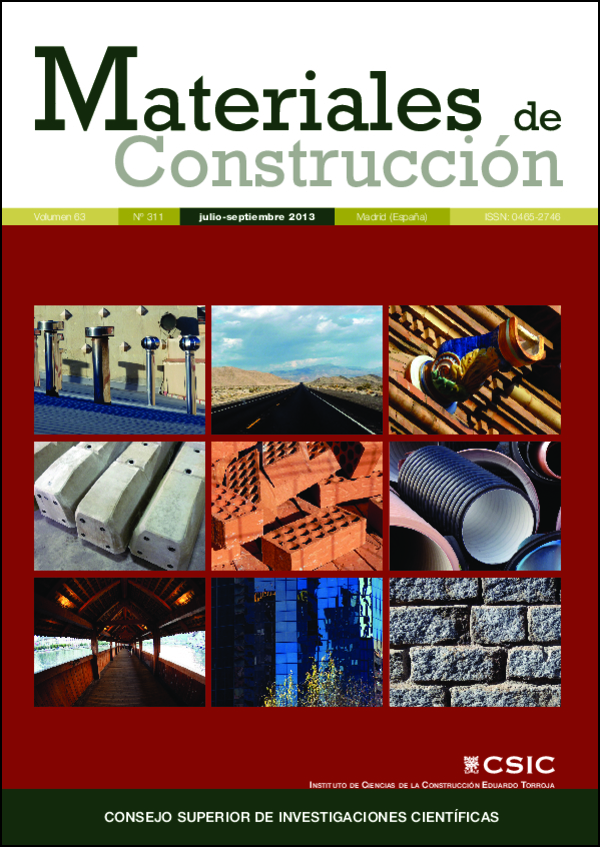Experimental and analytical study about the compressive behavior of eps sandwich panels
DOI:
https://doi.org/10.3989/mc.2013.01812Keywords:
sandwich panel, experimental campaign, compression, analytical formulation, EPSAbstract
This study presents a detailed characterization of the behavior of EPS sandwich panels subject to normal load taking into account several variables. For that, two experimental programs were performed, leading to the proposal of an analytical formulation to estimate the maximum load resisted. The results obtained show how the height of the panel, the material properties, the position and configuration of the reinforcement may affect the resistance of panels. Special attention should be given to the eccentric position of the reinforcement, which may reduce considerably the maximum load resisted. Some recommendations about the optimum placement of the reinforcement are proposed.
Downloads
References
(1) Carbonari, G.; Cavalaro, S. H. P.; Cansario, M.; Aguado, A.: “Flexural behaviour of light-weight sandwich panels composed by concrete and EPS”. Constr. Build. Mater. (2012), 35, 792-799. http://dx.doi.org/10.1016/j.conbuildmat.2012.04.080
(2) Einea, P. E. A.; Salmon, D. C.; Fogarasi, G. J.; Culp, T. D.; Tadros, M. K.: “State-of-the-art of precast concrete sandwich panels”. PCI J. November-December 1991, (1991), 78-98.
(3) Papanicolaou, C. G.; Triantafillou, T. C.: “Minimum cost design of concrete sandwich panels made of HPC faces and PAC core: the case of in-plane loading”. Structural Concrete (Journal of the fib). 5, 1, (2002), 11-27.
(4) Reis, E. M.; Rizkalla, S. H.: “Material characteristics of 3-D FRP sandwich panels”. Constr. Build. Mat. 22, 6, (2008), 1009-1018.
(5) Benayoune, A.; Samad, A. A. A.; Trikha, D. N.; Ali, A. A. A, Ellinna, S. H. M.: “Flexural behavior of pre-cast concrete sandwich composite panel – Experimental and theoretical investigations”. Constr. Build. Mat. 22, 4, (2008), 580-592.
(6) Bush, T. D.; Stine, G. L.: “Flexural behavior of composite precast concrete sandwich panels with continuous truss elements”. PCI J. March-April, (1994), 112-121.
(7) Attard, M. M.; Hunt, G. W.: “Sandwich column buckling – A hyperelastic formulation”. Int. J. Solid. Struct. 45, 21, (2008a), 5540-5555.
(8) Attard, M. M.; Hunt, G. W.: “Column buckling with shear deformations—A hyperelastic formulation”. Int. J. Solid. Struct. 45, 14-15, (2008b), 4322-4339.
(9) Pokharel, N.; Mahendran, M.: “Experimental investigation and design of sandwich panels subject to local buckling effects”. J. Constr. Steel. Res.. 59, 12, (2003), 1533-1552.
(10) Pokharel, N.; Mahendran, M.: “Finite element analysis and design of sandwich panels subject to local buckling effects”. Thin-Walled Struc.t. 42, 4, (2004), 589-611.
(11) Mousa, M. A.; Uddin, N.: “Global buckling of composite structural insulated wall panels”. Mater. Des.. 32, 2, (2011), 766-772.
(12) ACI Committee 318: “Building Code Requirements for Reinforced Concrete (ACI 318-89)”. American Concrete Institute, (1989).
(13) Benayoune A.; Samad A. A. A.; Trikha D. N.; Ali A. A. A.; Ashrabov A. A.: “Structural behaviour of eccentrically loaded precast sandwich panels”. Constr. Build. Mat.. 20, 9, (2006),713-724.
(14) Benayoune, A.; Samad, A.A.A.; Abang Ali, A.A.; Trikha, D.N. “Response of Pre-cast Reinforced Composite Sandwich Panels to Axial Loading”. Constr. Build. Mater.. 21, 3, (2007), 677-685.
(15) Cansario, M. M.: “Sistema constructivo de paneles aligerados con poliestireno expandido y malla electrosoldada espacial: estudio estructural y optimización”. PhD Dissertation. Universidad Politécnica de Cataluña, Barcelona, Spain, (2005)
(16) Shutt, C. A.: “Report Codifies, Details Sandwich Wall Panels”. ASCENT 1997. Spring, (1997), 28-33.
(17) Gere, J. M.; Goodno, B. J.: “Mechanics Of Materials”. 7th ed, Cengage-Engineering. ISBN 0495438073, (2008).
(18) EHE: “Instrucción de hormigón estructural”. Ministerio de Fomento de España. Madrid, (2008).
Downloads
Published
How to Cite
Issue
Section
License
Copyright (c) 2013 Consejo Superior de Investigaciones Científicas (CSIC)

This work is licensed under a Creative Commons Attribution 4.0 International License.
© CSIC. Manuscripts published in both the printed and online versions of this Journal are the property of Consejo Superior de Investigaciones Científicas, and quoting this source is a requirement for any partial or full reproduction.All contents of this electronic edition, except where otherwise noted, are distributed under a “Creative Commons Attribution 4.0 International” (CC BY 4.0) License. You may read here the basic information and the legal text of the license. The indication of the CC BY 4.0 License must be expressly stated in this way when necessary.
Self-archiving in repositories, personal webpages or similar, of any version other than the published by the Editor, is not allowed.


















